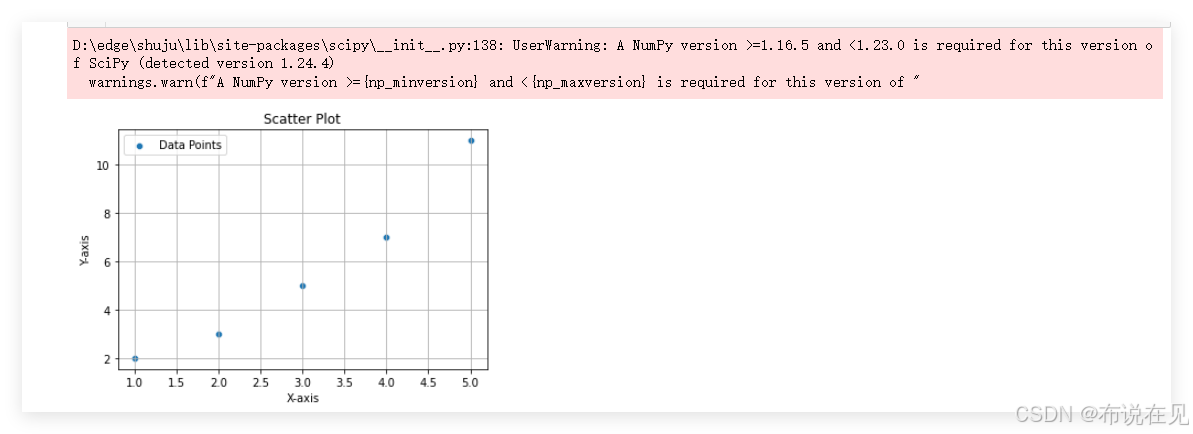目录
数据可视化1.使用 matplotlib 库matplotlib 库 2 .使用 seaborn 库seaborn 库 3 .使用 pyecharts库pyecharts库 注意1. 确保安装了所有必要的库2. 检查Jupyter Notebook的版本3. 使用`render()`方法保存为HTML文件4. 使用`IFrame`在Notebook中显示HTML文件5. 检查是否有其他输出干扰6. 重启Jupyter Notebook 比较三种库的特点选择建议目标 总结

数据可视化
1.使用 matplotlib 库
import matplotlib.pyplot as plt# 创建数据x = [1, 2, 3, 4, 5]y = [2, 3, 5, 7, 11]# 使用matplotlib绘制散点图plt.scatter(x, y, label='Data Points', color='blue', marker='o')# 添加标签和标题plt.xlabel('X-axis')plt.ylabel('Y-axis')plt.title('Scatter Plot')# 添加图例和网格plt.legend()plt.grid(True)# 显示图形plt.show()
matplotlib 库
导入库:import matplotlib.pyplot as plt创建数据:x = [1, 2, 3, 4, 5] 和 y = [2, 3, 5, 7, 11]绘制散点图:plt.scatter(x, y, label='Data Points', color='blue', marker='o')添加标签和标题:plt.xlabel('X-axis'),plt.ylabel('Y-axis'),plt.title('Scatter Plot')添加图例和网格:plt.legend(),plt.grid(True)显示图形:plt.show() 2 .使用 seaborn 库
import seaborn as snsimport matplotlib.pyplot as plt# 创建数据x = [1, 2, 3, 4, 5]y = [2, 3, 5, 7, 11]# 使用Seaborn绘制散点图sns.scatterplot(x=x, y=y, label='Data Points')# 添加标签和标题plt.xlabel('X-axis')plt.ylabel('Y-axis')plt.title('Scatter Plot')# 添加图例和网格plt.legend()plt.grid(True)# 显示图形plt.show()
seaborn 库
导入库:import seaborn as sns 和 import matplotlib.pyplot as plt创建数据:x = [1, 2, 3, 4, 5] 和 y = [2, 3, 5, 7, 11]绘制散点图:sns.scatterplot(x=x, y=y, label='Data Points')添加标签和标题:plt.xlabel('X-axis'),plt.ylabel('Y-axis'),plt.title('Scatter Plot')添加图例和网格:plt.legend(),plt.grid(True)显示图形:plt.show() 3 .使用 pyecharts库
from pyecharts.charts import Scatterfrom pyecharts import options as opts# 创建数据data = [(1, 2), (2, 3), (3, 5), (4, 7), (5, 11)]# 创建散点图对象scatter = ( Scatter() .add_xaxis([x for x, y in data]) .add_yaxis("Data Points", [y for x, y in data]) .set_series_opts(label_opts=opts.LabelOpts(is_show=False)) .set_global_opts( title_opts=opts.TitleOpts(title="Scatter Plot"), xaxis_opts=opts.AxisOpts(name="X-axis"), yaxis_opts=opts.AxisOpts(name="Y-axis"), ))# 渲染图表# 如果在Jupyter Notebook中运行,使用render_notebook()scatter.render_notebook()# 如果在普通Python脚本中运行,使用render()保存为HTML文件# scatter.render("scatter_plot.html")pyecharts库
导入库:from pyecharts.charts import Scatter 和 from pyecharts import options as opts创建数据:data = [(1, 2), (2, 3), (3, 5), (4, 7), (5, 11)]创建散点图对象:scatter = Scatter().add_xaxis([x for x, y in data]).add_yaxis("Data Points", [y for x, y in data])设置系列选项:set_series_opts(label_opts=opts.LabelOpts(is_show=False))设置全局选项:set_global_opts(title_opts=opts.TitleOpts(title="Scatter Plot"), xaxis_opts=opts.AxisOpts(name="X-axis"), yaxis_opts=opts.AxisOpts(name="Y-axis"))渲染图表:在Jupyter Notebook中使用render_notebook(),在普通Python脚本中使用render("scatter_plot.html") 注意
如果你在Jupyter Notebook中运行这段代码,但是图表没有显示出来,可能是因为render_notebook()方法没有被正确执行,或者你的环境配置有问题。下面是一些可能的解决方案:
1. 确保安装了所有必要的库
首先,确保已经安装了pyecharts及其相关依赖。可以使用以下命令来安装:
pip install pyecharts2. 检查Jupyter Notebook的版本
确保使用的Jupyter Notebook版本支持render_notebook()方法。通常情况下,较新版本的Jupyter Notebook应该没有问题。
3. 使用render()方法保存为HTML文件
如果render_notebook()方法不起作用,可以尝试将图表保存为HTML文件,然后手动打开这个文件查看图表。
# 渲染图表并保存为HTML文件scatter.render("scatter_plot.html")保存后,你可以在文件浏览器中找到scatter_plot.html文件并双击打开它,查看图表。
4. 使用IFrame在Notebook中显示HTML文件
如果你希望在Jupyter Notebook中直接显示HTML文件,可以使用IPython.display.IFrame来实现。
from IPython.display import IFrame# 渲染图表并保存为HTML文件scatter.render("scatter_plot.html")# 在Notebook中显示HTML文件IFrame('scatter_plot.html', width=800, height=600)5. 检查是否有其他输出干扰
有时候,Jupyter Notebook中的其他输出可能会干扰图表的显示。确保在执行绘图代码之前没有其他输出。
6. 重启Jupyter Notebook
如果以上方法都不奏效,可以尝试重启Jupyter Notebook服务器,有时这可以解决一些临时性的问题。
比较三种库的特点
| 库 | 特点 | 适用场景 |
|---|---|---|
matplotlib | 基础库,支持自定义,静态图表 | 科研论文,数据分析报告 |
seaborn | 基于 matplotlib,样式美观 | 统计分析,探索性数据分析 |
pyecharts | 交互性强,适合网页展示 | 数据展示,交互式仪表板 |
选择建议
如果需要在科研或数据分析中生成静态图表,matplotlib 是基础且可靠的选择。需要更多美观效果和便捷的统计分析时,seaborn 提供了友好的界面。若要在网页中展示交互式图表,pyecharts 能生成包含交互功能的 HTML 文件,非常适合网络发布。 目标
学习和实践:通过实际操作,掌握使用matplotlib、seaborn 和 pyecharts 绘制散点图的方法。比较不同库的特点:了解每个库的优缺点,选择最适合具体需求的工具。数据可视化:通过散点图展示数据之间的关系,帮助更好地理解和解释数据。 总结
嘿,数据可视化这事儿暂时要告一段落啦,不过以后有机会的话,咱还能再写写关于数据可视化的东西。?